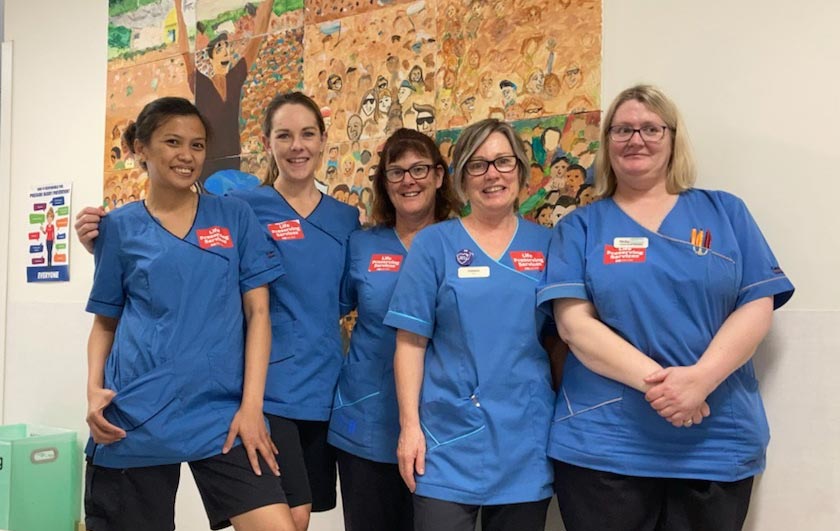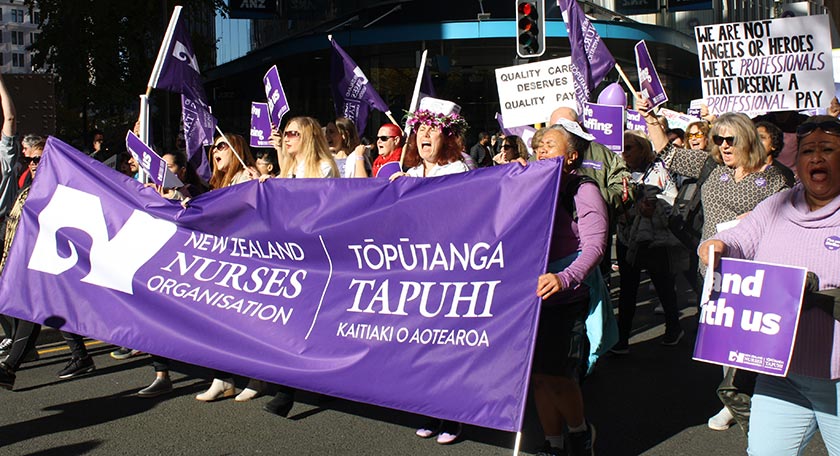
Around the country, nurses walked off the job at 11am on Wednesday, June 9. Some were piped out by bagpipes, others chanted loudly, some were called to action by a haunting conch shell which made the spine tingle.
The tides of purple and the amazing public show of support for nurses, midwives and health-care assistants working in the district health board (DHB) sector were breath-taking.
The organisation by NZNO members, staff and supporters too was truly phenomenal.
However, none of this could have happened without hundreds of hours of intense preparation behind the scenes in the weeks leading up to the action – in particular, over the 14 days running up to the strike.
Nursing and midwifery services are considered essential, therefore provisions apply to our industry that do not apply to others, because a complete withdrawal of labour would place lives at risk. Those who work to provide the care on the days of the strike are as much a part of the action and are NOT strike breakers.
The actions of the few allow the many to express their anger and frustration and uphold the right to strike. They prevent legal action being taken against NZNO for failure to meet our side of the agreement.
Those who work to provide care on the days of the strike are as much a part of the action and are NOT strike breakers.

Over the past few weeks, we have all heard a great deal about “LPS” – life-preserving services – as they relate to the current industrial situation and ongoing negotiations.
The provision of LPS during strike action is mandated in the Employment Relations Act (2000) code of good faith for the public health sector.1 This defines LPS as:
- Crisis intervention for the preservation of life.
- Care required for therapeutic services without which life would be jeopardised.
- Care required for therapeutic services without which permanent disability would occur.
In 2021, we have applied lessons learned from the 2018 strike and recommendations of former Council of Trade Union president Ross Wilson, who reviewed how the contentious 2017/18 DHB negotiations were conducted.
His recommendations included putting much greater power in the hands of the members to see through this process. The last week before the strike is key to its success – this is when the LPS numbers are agreed and then the rosters populated.

It was disappointing to note again that in some areas, staffing requests were made by DHBs that did not reflect how nurses work on any other day of the year – which is in situations that are unsafe and understaffed. These requests were taken through to adjudication.
For example, one DHB argued for more RNs for its LPS than are normally rostered on a standard night shift – a situation NZNO has long-argued was unsafe.
Unsafe staffing is a key concern of members and a major reason for going down the path of industrial action. While some DHBs have had good success and considerably boosted their full-time-equivalent staff numbers, as many as 50 per cent had not fully implemented safe staffing programme care capacity demand management (CCDM) in the required time frame by June 31.
LPS provision on the strike day can cause distress, especially when an employer is putting pressure on staff to undertake prescribed tasks or to function as if it is a “normal” day or business as usual. It is not a normal day and the staff who work on the floor during the period of strike action do not have the capacity to provide normal care. Ensuring patient safety by decompressing, reducing volumes and providing supports for patient care is the role of the employer.
The employer must also abide by this and should not be pressuring staff to undertake particular “tasks”. This is not only against the spirit of the code of good faith, but devalues the roles of nurse and midwives and can potentially put patients at greater risk.
Nurses and midwives must apply their professional judgement to the situation and care provided will be specific to the patient context. Nurses and midwives remain accountable for their practice.
NZNO can only provide guidance and cannot provide an exhaustive list of what you should and should not do as a life-preserving services responder.
Workers must use their own critical thinking in every situation to decide whether an action is directly life-preserving or will prevent harm and permanent disability.
However, the DHBs also have to be supporting patients’ safety – it’s not the sole preserve of LPS staff to ensure patients are safe and cared for.

During strike action, the DHB has certain obligations under the code. It is the employer’s role to ensure that the risk to patient safety is minimised during this time.
There is a need to decompress – reduce patient numbers as far as this is possible, ie working only with acute and time-critical needs.
It is also up to the employer to make alternative arrangements so that the the usual duties and activities of nursing staff are supplemented/supported by other health professional and workers during the strike action.
Flimsy excuses that “doctors cannot triage” or others cannot access records systems or medication-dispensing systems such as Pyxis are systems issues which need to resolved – not used as an excuse to fail to comply with their part of the bargain. That is, to facilitate staff having a right to strike, while ensuring public safety.
See also Away from the picket line – those who stay behind.
Reference
This shared NZNO industrial-professional viewpoint replaces the usual industrial and professional focus sections this month.



